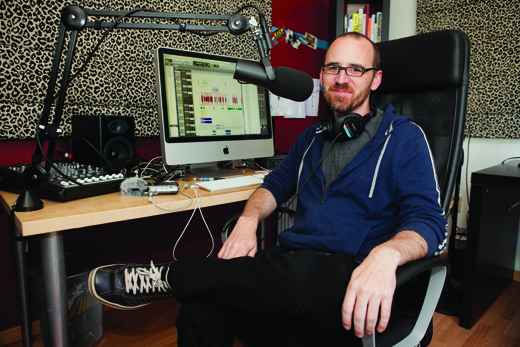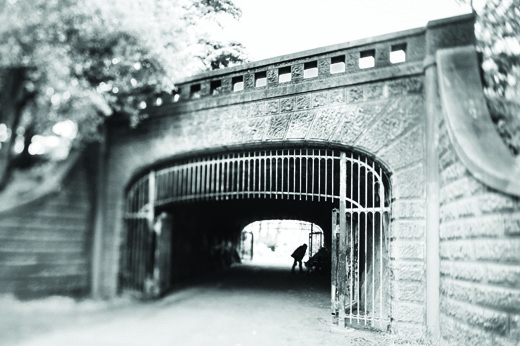
Photo by Raymond Ahner
Roman Mars describes himself as “a public radio fanatic that turned pro.” He taught himself the basics of interviewing and production and applied for every internship he could find with no luck. And then, KALW, which “was so small that it had no formal internship program at the time,” says Mars gave him a shot. Mars worked on every show that would allow him, working as a volunteer producer for three years until he got my first full time job at WBEZ in Chicago.
Then he launched 99% Invisible, which he describes as a tiny radio show about design. The popular program (and podcast) has covered a broad array of design and architecture topics from revolving doors to DIY space suits, cul de sacs to slot machines.
Why do a radio show about design rather than, say baseball or politics? What does the format bring to design that others don’t?
I like design because it’s a process, and where there’s a process, there’s a story. Architecture and design have a bevy of very invested characters that have strong opinions and can provide an enthusiastic, geeky energy to a radio piece (Note: This person is sometimes me).
What’s the biggest challenge of discussing design on the radio?
Covering design on the radio can be a challenge for obvious reasons, but being audio-only is a constraint that generally works in my favor. Most film documentaries about design are wall-to-wall lovely, close up images of curved teapot handles and funky chairs. When you can’t rely on that, you have to stick to the objects that have the best story, but aren’t necessarily the most beautiful. I also think audio allows me to widen the field a bit. When the images are secondary, the parallels between all the thought that goes into designing a flag and all the thought that goes into designing a public square are easier to fit into the big tent of design.
The biggest challenge is making sure, when I do describe something visual, that I’m doing a good job and the writing creates an accurate image in the listener’s mind. It’s pretty easy to convince myself that the building or graphic I’m describing is clear and easy to grasp, but people don’t listen that intently to the radio, so I have to step back, reinforce all the images through story elements, and create the piece in such a way that the content, tone and rhythm is pleasing, even if the listeners don’t grasp everything perfectly the first time they hear it.
We were lucky enough to have you devote a program to our 2013 exhibition “Unbuilt San Francisco.” What struck you in particular about the show?
Fundamentally, “Unbuilt” was fun. I loved how the subject resonated with everyone. I think people are less cynical when it comes to unbuilt structures. We enjoy the Jetsons-style possibilities and we also revel in the bullets we dodged. It also gave me a new lens for viewing things we actually built. It wasn’t until I saw the giant Marincello model that I fully understood the Headlands.
Photo by Eddy Joaquim
From that event I know that you loathe the “what’s your favorite building” question so...what building has made the best story?
My favorite stories about buildings are the ones where you learn a little detail and then the whole, massive structure snaps into focus and you really see it for the first time. I always retell the story of the Montgomery Ward building in Chicago. It’s not a very memorable building, especially for Chicago, but it has really thick concrete supports on each of the four corners of the building. They really take up a lot of room on the outside of the building. I never really thought about why it was designed that way, then someone told me why the big concrete corners were there. First they open up the floor plan, but most importantly, to me, anyway, was that the Montgomery Ward company prided itself on a more egalitarian hierarchy and didn’t want executives fighting over who got the corner office. So the design eliminates any possibility of a corner office at all. I’d never conceived of a building quite in that way before, as a machine to enforce the will of a company. I’ve never told that story on the radio, but it was a real turning point for me in how I looked at architecture.
What is one of the most surprising things where you went, “Oh yeah, someone had to design that!”
One of the very first stories I did was about Lunar redesigning a toothbrush and discovering, after tons of research and endless prototypes, that a straight handle was the best shape for a toothbrush. It’s not trying to do anything fancy or look “designed.” Straight was just better. I think we sometimes chase an abstract notion of “innovation” instead just focusing on getting better at what we’re already doing. Most of the time, we could just stand to be better.
Most fascinating urban design story you’ve done?
The story Sam Greenspan reported on called the “Arsenal of Exclusion,” which looked at Baltimore’s legacy of using the built environment to separate the city into rich and poor, black and white. Even though politics may have progressed somewhat, urban design choices continue to resonate through generations.
How did you get interested and cities? And which one is your favorite?
I don’t think I can say anything but San Francisco, right? The thing is, I don’t love San Francisco because it is perfect, I just find it fascinating because I don’t think it’s ever really figured out what kind of city it wants to be. Is it a car city or a mass transit city? Politically it’s progressive, but so many aspects of the built environment are almost comically conservative. SF’s most iconic building, the Transamerica Pyramid, really captures the character of the city in this way. Depending on where you’re standing, it’s either a beautiful silhouette or a big old mess. I love that.
I also went to Pittsburgh recently and thought it was lovely. I think people from Pittsburgh are purposely keeping that fact quiet.
Can you tell us an unknown but significant Bay Area curiosity that our readers could visit?
If you want significant, go to the Alvord Lake Bridge on the eastern edge of Golden Gate Park. It’s a dumpy and neglected thing, but it also happens to be one of the oldest standing reinforced concrete structures. It’s a literal bridge to the modern world. Normally, being “important” isn’t a compelling reason to enjoy anything. I always say, “Important is the least interesting form of interesting.” In this case, however, the juxtaposition of its willful homeliness and its role in history is striking.

